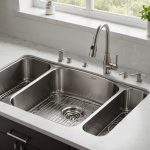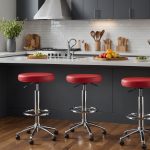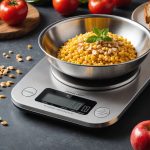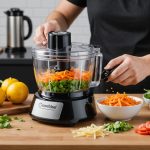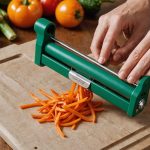Key Features of Hand Blenders
When selecting a hand blender, understanding its essential features is crucial for ensuring optimal performance. Blending capabilities heavily depend on both the motor and blade design, which play a pivotal role in achieving desired textures.
Importance of Motor Power
A hand blender’s motor power directly influences its effectiveness. Stronger motors, measured in wattage, allow for smoother blending, particularly with tough ingredients. Efficient motor performance ensures the device handles prolonged use without overheating, providing a higher blending power capacity.
Also to see : Choose the Perfect Vegetable Peeler for Waste-Free Cooking: A Complete Guide
Blade Design Considerations
Equally important is the blade design. Different types of blades cater to specific needs, affecting blending technology and cutting efficiency. Smooth textures often result from well-designed blades that facilitate efficient mixing actions.
Ease of Cleaning
Modern blenders boast removeable components, promoting cleaning convenience. Materials such as stainless steel resist stains and odors, enhancing long-term use. These user-friendly designs are particularly appreciated for their straightforward maintenance features.
Topic to read : Discover the Perfect Kitchen Scale: A Guide to Measuring in Metric and Imperial Units!
Versatility for Multiple Uses
Many models now offer multifunctional blenders with various attachments. These enhance your cooking experience by expanding the blender’s capabilities beyond soups to include smoothies, sauces, and more. Embracing versatility can unlock new culinary opportunities.
Ergonomic Design and Comfort
Ergonomic user comfort is ensured through thoughtful grip and handle designs. Considering weight distribution and handle shape is vital for prolonged blending, increasing overall satisfaction with the appliance.
Recommendations and Comparisons
Navigating the world of hand blenders can be complex, with numerous models available. Understanding the top hand blenders is crucial to making an informed choice. When comparing models, consider attributes like motor power, blade design, and additional attachments.
Popular Models for Soup Making
When selecting a hand blender for soups, look for models with higher motor power and efficient blade designs. Brands like KitchenAid and Braun offer robust options, known for their powerful motors and versatile functionality. These models typically have blending capabilities ideal for achieving smooth textures.
Feature Comparisons of Top Picks
It’s essential to compare features across models to find one that suits your needs. Common features to assess include removable components for ease of cleaning, and ergonomic handle designs for user comfort. Innovative models often come with multiple attachments, enhancing their multifunctional use.
Price Ranges and Value for Performance
While budget plays a role, prioritising hand blender qualities can significantly impact your satisfaction. Price ranges vary widely, with some high-end models delivering superior performance and longevity. Investing in a model with a balance of features and quality ensures excellent value for money, ultimately enhancing your blending experience.
Tips for Preparing Soups
To unlock the full potential of your hand blender, mastering a few soup preparation techniques can greatly enhance your culinary prowess. Begin by ensuring your ingredients are uniformly chopped to facilitate smoother blending. This not only enhances blending tips but also reduces strain on the motor, promoting longer-lasting performance.
When aiming for a velvety consistency, consider the ingredient selection. Opt for fresh, high-quality vegetables and seasonings, as these elements profoundly influence the final taste and texture. Including a balance of soft and fibrous components can help achieve a balanced texture that your handheld blender can efficiently process.
Techniques for Achieving Consistency
Before blending, cook ingredients thoroughly till tender. This step improves the blending process, creating a more consistent soup texture. Additionally, gradually adding stock or liquid aids in achieving the desired thickness, offering better control over the soup’s consistency.
Incorporating different blending methods, such as pulsing or continuous blending, provides control over texture. Blending tips like these ensure you enjoy a smooth and lump-free soup every time.
Ideas for Flavor Enhancement
Enhance flavours with spices and herbs added gradually. This method, compatible with hand blenders, avoids over-seasoning. Incorporate fresh herbs at the end for a burst of flavour that elevates your soup preparation.
Blade Design Considerations
Understanding the blade types and how they contribute to the hand blender’s performance is essential for achieving smooth textures. Different blade designs play a significant role in cutting efficiency, directly impacting the quality of your blends. For instance, curved blades often offer better mixing capabilities than flat blades, leading to more consistent results.
Different Blade Designs and Their Uses
Blade designs vary in shape and purpose. Some blades are specifically designed for chopping, while others are crafted for pureeing or blending. Precision in blending technology is achieved through tailored blade shapes that enhance different cooking tasks.
How Blade Shape Affects Performance
The shape of a blade influences how ingredients are processed. Sharp, angled blades create faster rotations, optimizing cutting efficiency and reducing blending time. This precise movement is crucial in obtaining desired textures, particularly when dealing with fibrous or tough ingredients.
Durability of Blades and Maintenance Tips
Durability is a key feature of hand blender blades, often determined by the material used. Stainless steel is a popular choice for its resistance to wear and rust. Regular maintenance, such as thorough cleaning and careful storage, extends the life of your blades, ensuring consistent performance over time.
Versatility for Multiple Uses
The multifunctional nature of many hand blenders transforms them into invaluable kitchen tools. These appliances not only create soups but also excel at preparing a variety of recipes. From smoothies to sauces, the enhanced versatility in cooking elevates culinary possibilities.
Additional attachments further boost the utility of hand blenders. Attachments like whisks and choppers expand the range of tasks your blender can handle, complementing its blending capabilities. By adjusting for specific tasks, these accessories help achieve optimal results, catering to diverse cooking needs.
Leveraging the full potential of your multifunctional blenders involves understanding how to maximise its use. Explore various attachments to diversify the range of dishes you can prepare. A practical approach includes carefully reading the manufacturer’s guidelines to ensure each accessory is used effectively.
For new recipes, experiment with different speeds and settings to find what works best for your ingredients. The adaptability offered by versatile blenders fosters culinary creativity, allowing cooks of all skill levels to explore expanding their repertoire effectively while maintaining efficiency in the kitchen. Embrace the opportunities that this versatility offers for a seamless, efficient cooking experience.
Ease of Cleaning
Ensuring cleaning convenience is a significant aspect of selecting a hand blender. Many modern designs highlight user-friendly features that make maintenance a breeze. Removable components are particularly beneficial, as they allow for straightforward washing, ensuring that your appliance remains hygienic and efficient over time. Look for blenders with dishwasher-safe parts, as these further ease the cleaning burden and save precious time during kitchen clean-up.
Importance of Removable Components
Easy removal of components such as the blending shaft and blades facilitates effortless cleaning. This maintenance feature not only ensures thorough hygiene but also extends the appliance’s lifespan by preventing food residue build-up.
Recommended Materials for Easy Cleaning
When it comes to materials, stainless steel is highly recommended. Its stain-resistant properties mean it doesn’t easily retain odours or discolourations. This material choice enhances long-term use, making stainless steel components a preferred option for frequent users.
Innovative Designs for Maintenance
Recent innovations in blender designs focus on ease of maintenance. Some models feature twist-lock systems, simplifying assembly and disassembly. This enhances the user experience, allowing you to focus more on cooking rather than cleaning, transforming kitchen tasks into less of a chore.
Ergonomic Design and Comfort
When selecting a hand blender, ergonomic features are critical for ensuring user comfort. An ideal grip design and thoughtful weight distribution can significantly enhance the usability of the appliance, making it easier to operate during prolonged periods.
Importance of Handle Design for Prolonged Use
The handle design plays a pivotal role in maintaining comfort during extensive blending. Ergonomic handles, often shaped to contour to your hand, minimize strain and fatigue. This design ensures you stay comfortable even during lengthy cooking sessions, improving overall satisfaction.
Factors to Consider for Comfort During Blending
Several factors contribute to a comfortable blending experience. User comfort hinges on handle material, grip texture, and the overall design of the blender. Models crafted with soft, non-slip materials offer increased stability and reduce the likelihood of accidents, which is particularly valuable in busy kitchens.
How Weight Distribution Impacts Usability
A well-balanced blender evenly distributes weight, preventing wrist fatigue. Proper weight distribution ensures smooth handling, making it easier to manage the appliance throughout various tasks. By considering these aspects, users can select a blender that seamlessly integrates into their daily culinary routines, enhancing both efficiency and enjoyment in the kitchen.
Tips for Preparing Soups
To ensure your hand blender consistently delivers optimal results, mastering several soup preparation techniques is essential. Begin by preparing your ingredients properly: cutting them into uniform sizes not only facilitates smoother blending but also prolongs the blending power of your device. This practice reduces strain on the motor, enhancing its longevity.
Techniques for Achieving Consistency
Achieving a velvety soup texture requires adequately cooking ingredients until they’re tender. This method eases the blending process, leading to more consistent results. Additionally, gradually incorporating stock or liquid helps control the thickness, promoting effective blending techniques.
Ideas for Flavor Enhancement
Enhancing flavours involves a strategic approach. Incorporate spices and herbs slowly, as this helps prevent overpowering the soup. Adding fresh herbs at the end of the blending process maximizes their aromatics, perfect for uplifting the soup’s final taste. Prioritizing these blending tips will ensure your culinary creations are always enjoyable.
By closely following these ingredient selection techniques and focusing on the detailed preparation of soups, you can unlock the full potential of your culinary skills, making every spoonful an unforgettable experience, and simultaneously maintaining the efficiency and durability of your hand blender.


